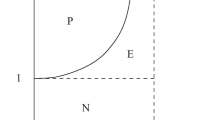Abstract
We use analytical methods to investigate a continuous vaccination strategy’s effects on the infectious disease dynamics in a closed population and a demographically open population. The methodology and key assumptions are based on Breda et al. (J Biol Dyn 6(Sup2):103–117, 2012). We show that the cumulative force of infection for the closed population and the endemic force of infection in the demographically open population can be reduced significantly by combining two factors: the vaccine effectiveness and the vaccination rate. The impact of these factors on the force of infection can transform an endemic steady state into a disease-free state.




Similar content being viewed by others
References
Andersson H, Britton T (2000) Stochastic epidemic models and their statistical analysis. Lecture notes in statistics. Springer, New York
Breda D, Diekmann O, de Graaf WF, Pugliese A, Vermiglio R (2012) On the formulation of epidemic models (an appraisal of Kermack and McKendrick). J Biol Dyn 6(Sup2):103–117 PMID: 22897721
Corless RM, Gonnet GH, Hare DEG, Jeffrey DJ, Knuth DE (1996) On the Lambert \(W\) function. Adv Comput Math 5(1):329–359
Diekmann O, Heesterbeek H, Britton T (2013) Mathematical tools for understanding infectious disease dynamics. Princeton University Press, Princeton
Huppert A, Katriel G (2013) Mathematical modelling and prediction in infectious disease epidemiology. Clin Microbiol Infect 19(11):999–1005
Kermack WO, McKendrick AG (1927) A contribution to the mathematical theory of epidemics. Proc R Soc Lond Ser A 115(772):700–721
Kermack WO, McKendrick AG (1932) Contributions to the mathematical theory of epidemics. II.—the problem of endemicity. Proc R Soc Lond Ser A 138(834):55–83
Meehan MT, Cocks DG, McBryde ES (2017) Global stability of a general, scalar-renewal epidemic model. arXiv preprint arXiv:1707.03489
Acknowledgements
This research was supported in part by a Discovery Grant to N. Madras from the Natural Sciences and Engineering Research Council of Canada. The authors wish to thank Mahnaz Alavinejad and Jianhong Wu for discussions of the paper of Breda et al. (2012).
Author information
Authors and Affiliations
Corresponding author
Additional information
Publisher's Note
Springer Nature remains neutral with regard to jurisdictional claims in published maps and institutional affiliations.
Rights and permissions
About this article
Cite this article
Nzokem, A., Madras, N. Epidemic Dynamics and Adaptive Vaccination Strategy: Renewal Equation Approach. Bull Math Biol 82, 122 (2020). https://doi.org/10.1007/s11538-020-00802-2
Received:
Accepted:
Published:
DOI: https://doi.org/10.1007/s11538-020-00802-2




